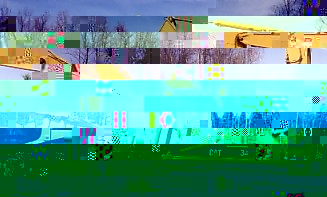The sets of photos shown below, show "before development" and "after development" images of Waterford's "Woodland Pond" single family homes community on Lot 8, north of Countryside Boulevard and near the periphery of the apartment building complex.
In the first set of four photographs,taken in the summer of 2002, a great blue heron rookery is shown on a beaver pond. (The nests visible in the snags, or dead trees, constitute a rookery.) The photograph to the right shows the base of some of the snags at higher magnification. In the center of the photograph, a great blue heron can be seen perched on a log.
Beneath the rookery photograph are two photographs (left, taken at one end of the pond and right, a close-up of the pond's end that shows a primitive beaver dam near the end of the pond in more detail.) Site plans for the community of homes to be located in this region show that homes will be built directly along one side of the pond. Great blue herons are reported to abandon nests whenever there is human activity nearby, and it is likely that beaver activity will also be disrupted.
In the second set of photographs, taken in the spring of 2003 near Countryside Boulevard, deforestation, road building and marketing of the area are seen to be well underway at the entrance to the property.

The land clearing and road building continued into the interior of the property and by late summer, some house lots were demarcated. The left photograph below is of a house lot that is near the road, but at the top of a fairly steep slope leading to an abandoned beaver pond. (note snags throughout the pond.) At the bottom of the slope near the wetlands, as shown in the right photograph below, a sagging, nearly collapsed silt fence is visible amidst ferns. (A largely intact upright silt fence is shown at the upper right corner of this same photograph.) Construction-related activities on this particular lot appeared to be quite intensive and doubtless much material from these activities entered the wetlands.
BACK TO EXTENSIVE RESIDENTIAL DEVELOPMENT HOME